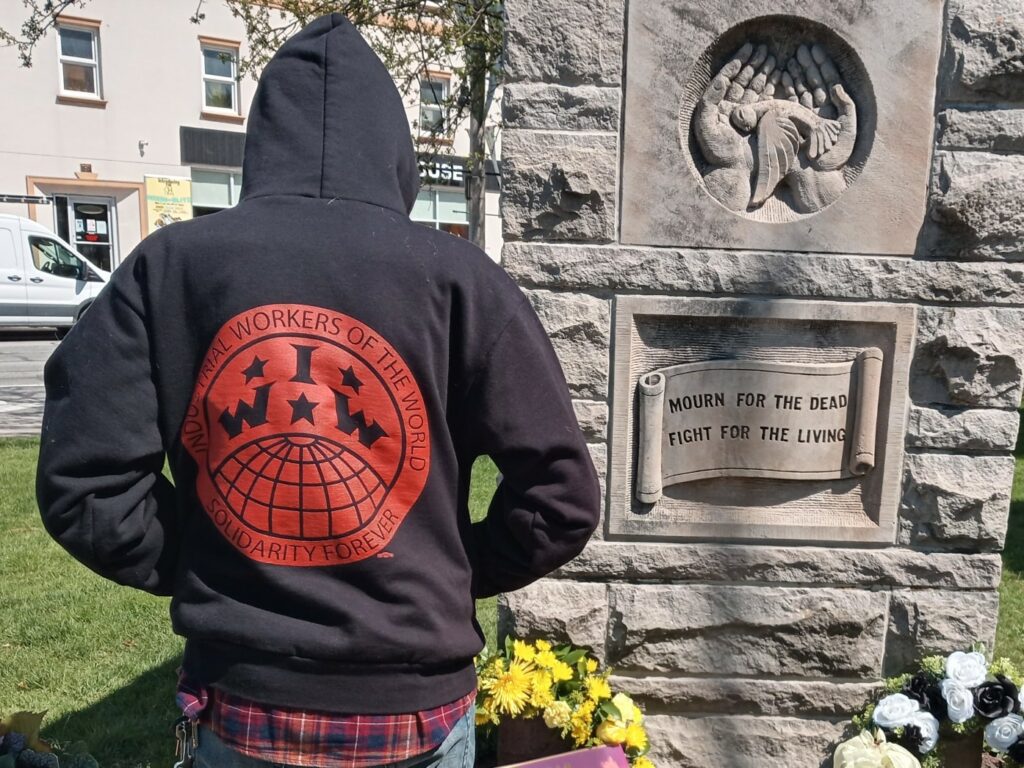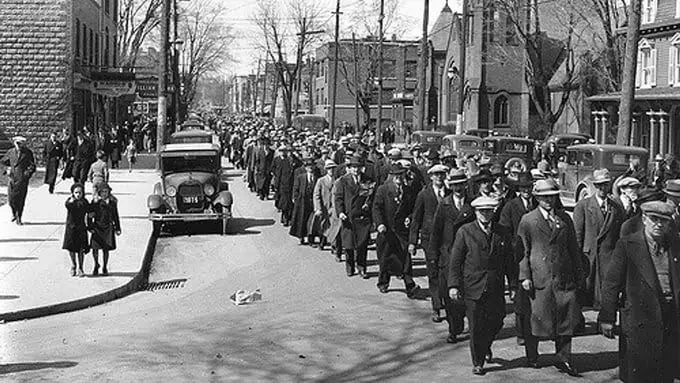
The labor history of Oshawa has affected workers’ rights in the whole of so-called Canada. Because of this, the capitalist class does everything in its power to sweep Oshawa’s radical history under the rug. In particular, efforts have been made to destroy the memory of Oshawa’s 1937 Auto workers strike. Still, the 1937 General Motors strike was, and remains, a landmark strike in the history of Canada’s workers’ struggle, and one that contains many lessons for the Canadian labor movement today. It’s commonly accepted that the Strike of ‘37 was the turning point that the CIO, or Congress for Industrial Organizing, needed to begin organizing in Canada.
Before the CIO began trying to organize in so-called Canada, the IWW had already been made illegal by the federal government in 1918. This was done as part of the red scare, because of fear of radical publications, and racism against people from Eastern Europe. This fear, anti-union sentiment and red-baiting would have residual effects on the political landscape which would bring a lot of unnecessary politicking and bureaucracy against the Oshawa auto workers during the strike of ‘37. The CIO and IWW did have some structural differences. The IWW was, and still is, one big union whereas the CIO was closer to being a semi-industrial federation of unions. The IWW always organized those most marginalized, women, BIPOC, unskilled laborers, the poor, and recent immigrants. The IWW has always aimed to replace capitalism with a society run by workers. The end goal of IWW organizing and unionization is to overthrow capitalism and do away with the wage system.
Prior to GM purchasing the McLaughlin Carriage Works, Oshawa was primarily a small city with an economy centered around agriculture and small scale farms. Once the first GM plant opened in Oshawa the economy switched to the basic industry being automobiles and GMC being the main employer. Right away the class antagonisms between workers and bosses began to surface on the factory floor. Low wages, unsafe working conditions, and lack of job security prompted a walk out in 1928 that lasted less than a week before the company gave in to the workers’ demands. The walkout was successful because the workers came together with a common goal and were willing to do direct action to get the goods.
The workers tried to form a union and affiliate with the Trades and Labour Congress, the Canadian counterpart of the American Federation of Labour. However the TLC wanted to break the union into smaller sections by trade. Oshawa workers knew that they were stronger in one big union together and refused to weaken their collective power. They then tried to affiliate with the Auto Workers’ Industrial Union of Canada but the TLC decided to kick up a bureaucratic shit show and get into a territorial pissing match, fighting over which union the workers should affiliate to. This resulted in no union being formed for the workers. This wasted so much time that it lasted until the start of the depression in the 1930s, when lack of job security led to the workers temporarily giving up on forming a union.
As the depression came to an end the bosses at GMC had taken full advantage of the demoralized workforce; sexism, lack of job security, assembly line speedups, lower wages and longer hours were rampant on the shop floor. Women reported workplace sexual harassment on a regular basis, and all workers were subjected to invasive medical exams that often found arbitrary reasons not to re-hire workers over 40 after long seasonal layoffs. This led to Body Shop workers downing tools and walking off the job in February of 1937. They called the UAW and began signing up members to the union. Within a month 4000 workers were unionized.

GMC immediately began battling the unions’ organizing efforts. They attempted to transfer militant workers to different sections of the plant in an effort to divide organizing efforts, increasing shifts to doubles thus attempting to cut down on time spent organizing, and even sending company spies to union meetings to collect names and identify those most militant and dedicated to organizing. It was all for naught because the workers would not back down.
The CIO was beginning to attempt organizing in Canada after having success in the auto industry in Flint and Detroit. Coinciding with what was happening in Oshawa the CIO was gaining some momentum north of the border. There were a few sitdown strikes taking place in various industries throughout Ontario, but due to aforementioned racism, redbaiting, state/capitalist repression and violence these sitdown strikes were having a hard time catching on and the CIO wasn’t gaining much footing in Canada.
The Oshawa Strike of ‘37 lasted from April 8th to 23rd, when over 4000 workers went on strike. Demands were an 8-hour workday, a steward and grievance committee, a seniority system, abolition of the new efficiency system (assembly line speed ups), a minimum wage, regular paydays, contracts, breaks on a regular schedule, better working conditions, and recognition of the union UAW Local 222. The question of “who won?” became a prickly issue because there was so much politicking involved in the strike. Firstly, Oshawa workers won all their demands. At a surface glance the wording of the contract does look like the CIO was held at bay, however they broke ground because of the strike and the Oshawa workers won as an industrial union rather than being broken down into individual crafts. Historians and labor militants recognize this is what brought the CIO into Canada, though at the time mainstream media and politicians said otherwise. Strikers even passed a resolution affirming the alliance with the UAW and CIO with which the union was affiliated and sent it to the Liberal premier of Ontario, Mitchell Hepburn.
Hepburn was elected on a promise of “I swing well to the left where some Grits do not tread” and began with a pro-labor platform, but like all politicians and elected officials he very quickly sold out and betrayed the working class. He detested the CIO and used the guise of being against violence and bloodshed, combined with thinly veiled redbaiting to try and break the new Oshawa union Local 222. He also became outspokenly pro-violence to break strikes especially the CIO sit down strikes going on in Ontario around the same time period. During the Oshawa strike itself he had a fascist meltdown, and hired and armed some private guards from University of Toronto, whom Oshawa workers called “Sons of Mitch’s” and media dubbed “Hepburn’s Hussars.” He also fired the majority of his cabinet because they wouldn’t bend to his idiocy and totalitarianism.
There is a lot of labor history, bureaucratic maneuvering, and politicking involved in the Strike of ‘37, that will be condensed or left out of this article for the sake of conciseness. One organizer from the USA told the strikers to let scabs cross the picket line for the illusion of “keeping the peace.” What would have happened if workers defied calls for liberal pacifism and held the line? A militant autoworkers strike just a year prior had the establishment terror stricken. There was a growing militant movement seemingly quelled by piece meal reformism. There were a lot of outside issues and politicking that to this day takes focus away from the workers which could have been avoided with direct action led by the rank and file autoworkers. Nonetheless, the Oshawa working class fought and defeated big business and the provincial government inspired workers throughout the county. Weakness is never what wins a strike. Aggression from the bosses needs to be met with a union coming together to fight and scare the hell out of the ruling class, which is exactly what the Oshawa working class did in ‘37.
Works Cited:
Durham Region Labour Council and Local 222 literature
Oshawa 1937 article from “On Strike!” By Irving Abella
“Discounted Labour: Women Workers in Canada 1870-1939” by Ruth A. Frager and Carmela K. Patrias
“The History of the IWW In Canada” G. Jewell
